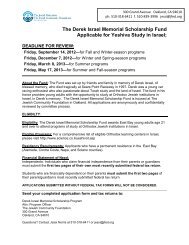East Bay Jewish Community Study - Jewish Federation of the ...
East Bay Jewish Community Study - Jewish Federation of the ...
East Bay Jewish Community Study - Jewish Federation of the ...
You also want an ePaper? Increase the reach of your titles
YUMPU automatically turns print PDFs into web optimized ePapers that Google loves.
Interviewing Process<br />
The interviews were composed <strong>of</strong> two portions:<br />
Screening.<br />
The survey began with a series <strong>of</strong> screening questions that required approximately 2.6 minutes<br />
to complete. These questions were asked <strong>of</strong> everybody reached on <strong>the</strong> phone, including those<br />
in both <strong>the</strong> <strong>Jewish</strong> and non-<strong>Jewish</strong> households. The goal <strong>of</strong> this first section was to assess<br />
whe<strong>the</strong>r <strong>the</strong> respondent or household qualified for <strong>the</strong> full survey, as well as to ga<strong>the</strong>r data<br />
necessary for making population estimates. Accordingly, <strong>the</strong> screening section began by<br />
recording basic respondent data (gender and age) and confirming that <strong>the</strong> household was<br />
located in <strong>the</strong> greater <strong>East</strong> <strong>Bay</strong> region. Then it asked about <strong>the</strong> number <strong>of</strong> landlines in <strong>the</strong><br />
household and <strong>the</strong> number <strong>of</strong> adults and children in <strong>the</strong> household (household size), information<br />
required for calculating population estimates. Finally, <strong>the</strong> last part <strong>of</strong> <strong>the</strong> screening section<br />
determined whe<strong>the</strong>r <strong>the</strong> household could be considered a <strong>Jewish</strong> household according to <strong>the</strong><br />
aforementioned criteria and, if so, how many people in <strong>the</strong> household were <strong>Jewish</strong>. (see figure<br />
97)<br />
Please note <strong>the</strong> ―skip logic‖ used in <strong>the</strong> part <strong>of</strong> <strong>the</strong> screening determining <strong>the</strong> <strong>Jewish</strong> status <strong>of</strong> a<br />
household. Individuals who indicated <strong>the</strong>y were <strong>Jewish</strong> in <strong>the</strong> religion question (RELIG1) were<br />
allowed to skip directly to <strong>the</strong> question asking <strong>the</strong> number <strong>of</strong> Jews in <strong>the</strong>ir household and <strong>the</strong>n<br />
moved onto <strong>the</strong> full survey. Individuals indicating no religion or ano<strong>the</strong>r, non-<strong>Jewish</strong>, religion<br />
were given several o<strong>the</strong>r opportunities to qualify: if <strong>the</strong>y considered <strong>the</strong>mselves to be <strong>Jewish</strong> in<br />
any way, if any o<strong>the</strong>r member <strong>of</strong> <strong>the</strong> household considered <strong>the</strong>mselves to be <strong>Jewish</strong>, or if <strong>the</strong>y<br />
or a household member were born or raised <strong>Jewish</strong>. At this point, if <strong>the</strong> interviewer reached a<br />
non-<strong>Jewish</strong> member <strong>of</strong> a <strong>Jewish</strong> household, every attempt was made to switch to <strong>the</strong> <strong>Jewish</strong><br />
member <strong>of</strong> <strong>the</strong> household.<br />
As it turned out, none <strong>of</strong> <strong>Jewish</strong> households that went on to complete <strong>the</strong> full survey required all<br />
<strong>of</strong> <strong>the</strong> follow-up questions. In fact, 49 percent indicated <strong>the</strong>y were <strong>Jewish</strong> in <strong>the</strong> first question<br />
about religion and <strong>the</strong> remaining 51 percent said <strong>the</strong>y considered <strong>the</strong>mselves <strong>Jewish</strong> in any way<br />
when asked directly. That means that none <strong>of</strong> <strong>the</strong> respondents were asked <strong>the</strong> questions about<br />
being born or raised <strong>Jewish</strong> and, if <strong>the</strong> respondent was not <strong>Jewish</strong>, whe<strong>the</strong>r <strong>the</strong>re was a <strong>Jewish</strong><br />
household member. There were five respondents that did qualify as <strong>Jewish</strong> households based<br />
on <strong>the</strong> follow-up questions, but <strong>the</strong>y all subsequently ―broke-<strong>of</strong>f,‖ or refused to complete <strong>the</strong><br />
survey.<br />
The <strong>Jewish</strong> Household Survey.<br />
The <strong>Jewish</strong> household survey was only administered to <strong>Jewish</strong> households, as determined by<br />
<strong>the</strong> interviewee’s responses in <strong>the</strong> screening portion. Following <strong>the</strong> screening, interviewees in<br />
non-<strong>Jewish</strong> households were thanked for <strong>the</strong>ir time and <strong>the</strong> interview was terminated. For<br />
<strong>Jewish</strong> households, <strong>the</strong> survey portion was administered immediately following <strong>the</strong> conclusion<br />
<strong>of</strong> <strong>the</strong> screening, although, if necessary, respondents could request and schedule a call-back<br />
time to complete <strong>the</strong> survey.<br />
99




